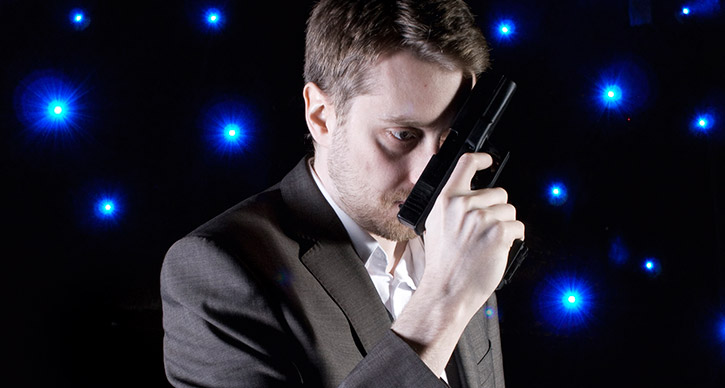When Bullets Flew

Photo: Rob Drummond in Bullet Catch. Bullet Catch is at the Arthur Miller Theatre in Ann Arbor on January 7-12, 2014. Photo courtesy of the artist.
Reviewing Bullet Catch for the New York Times a few months ago, Charles Isherwood noted that while the sound of gunfire onstage is hardly unusual, the shots in Bullet Catch “are more unsettling than most.” That’s because they’re real, because they’re fired by a volunteer from the audience, and because they’re aimed straight at the head of performer and creator Rob Drummond.
Drummond’s 75-minute show re-creates a stage trick that took off in Europe in the 17th century and remained popular well into the 19th—and on more than one occasion proved lethal. Drummond claims he’s exploring the idea of free will as an “illusion” by re-enacting the perilous stunt—and inviting an audience volunteer to join him—but Isherwood finds the whole thing “in terrible taste,” even though Drummond gives audiences a chance to leave just before the climactic “bullet catch.”
Performance trailer
I suspect Isherwood would have been none too happy with the 19th-century American stage, where actors repeatedly pulled out—and used—real firearms in yet another chapter in this country’s long and tumultuous love affair with guns. Before its renovation in the 1990s, my own favorite theater, the Fulton Opera House in Lancaster, Pennsylvania, built in 1852, was thought to bear the scar of at least one bullet on its proscenium arch—the result of a misfire by Buffalo Bill during one of his six appearances there between 1873 and 1882.

Buffalo Bill.
William F. Cody—aka Buffalo Bill—was perhaps the most famous practitioner of the so-called American “border drama,” but he had plenty of company. Go to a show in the late-19th century in one of the nearly 4,000 theaters that stretched across the nation, and you were likely to stumble on a play about Davy Crockett or Jesse James or Daniel Boone, about pioneers or rangers, miners or sharpshooters or Mormons with “one hundred wives.” The real American frontier may have been in its death throes, but the stage version was alive and well.
Audiences poured into theaters to see real “marksmen,” “sharpshooters,” “wing shots,” “rifle shots,” and “dead shots” shatter glass balls and tempt disaster. In his prairie dramas and Wild West shows, Buffalo Bill shot apples and potatoes from women’s heads and cigars from men’s mouths, often holding his rifle upside-down or firing backwards with the help of a mirror.
Cody seldom misfired, but others weren’t so lucky. On November 30, 1882, Frank Ivers Frayne killed his fiancee in front of a crowd of 2,300 inside Cincinnati’s Coliseum Theater.
Famed for the spectacular shooting stunts he wove into the plots of his plays (most of them set in the American West), Frayne was an expert marksman, capable of extinguishing a candle with a bullet, shooting a pipe out of a ranch hand’s mouth, firing a bullet through the rope of an innocent man about to be hanged, and shooting two guns simultaneously in two different directions, so that bullets shattered objects on either side of the stage—all tricks he performed during his 20-odd years of touring the country’s theaters. He taught his wife and two kids to shoot as well, and they often performed with him.
The backward shot
In his most daring stunt, “the backward shot,” Frayne blasted an apple off his wife’s head while propping his rifle on his shoulder and focusing in a mirror. (According to one account, the bullet sometimes not only pierced the apple but also triggered another rifle aimed at a plate suspended inches above Frayne’s head.) Ads reassured nervous theatergoers that the “backward shot” looked more dangerous than it was, because the actress wore a chain mail skullcap, and the apple rested on a six-inch hat.
After his wife’s death in 1880—apparently from natural causes—Frayne hired a 23-year-old actress named Annie Von Behren to be his assistant in the stunt, and the two became engaged.
At a matinee performance on Thanksgiving afternoon in Cincinnati on November 30, 1882, Frayne set up his backward shot as usual and pulled the trigger. A sudden burst of smoke enveloped his head, burning Frayne’s face and neck. The unexpected blast shoved the barrel of his rifle down by a few lethal inches, and with 2,300 people looking on, a bullet shattered Annie’s forehead. “My God! My God! What have I done?” Frayne bellowed as he rushed to her side. The curtain came down, and backstage, with Frayne moaning beside her, Annie Von Behren died. Frayne was charged with manslaughter but exonerated. He resumed performing in early 1883, some four weeks after the accident, but in a nod to safety he abandoned his most dangerous stunts. He continued to tour until his death in 1891.
Neither Frayne nor his promoters seemed to mind capitalizing on the tragedy. Announcements for his shows invariably mentioned Annie’s death, with graphic accounts of Frayne’s rushing to her and swooning over her corpse. The actor, papers reported, “is broken down with uncontrollable grief.” It was all theater—as is, I sometimes think, our contemporary fascination with guns and the tragedies they spawn.
And as I hope Bullet Catch will be. Asked if either the audience or he himself is in actual danger during the show, Rob Drummoned has said, “Them, no. Me, yes.” I have a sneaking suspicion I may be one of those audience members who heads for the exit when given the chance.
Interested to know Leslie’s post-performance response? Come back to UMS Lobby’s “People are Talking” section after the performance.






